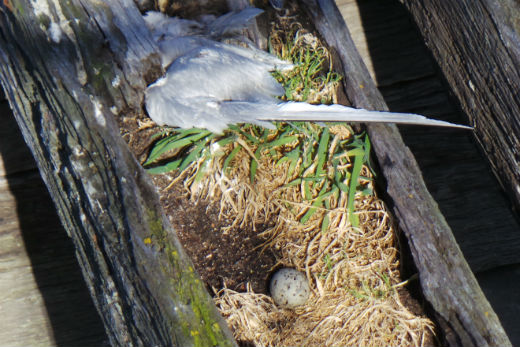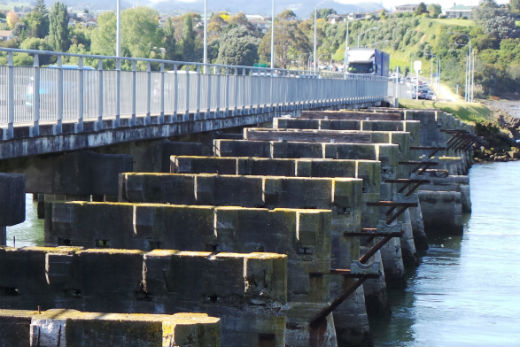The white-fronted tern colony on Hairini bridge is under attack from humans, and fears are held for the colony's future.
The bridge colony lives on the pile frames of the old wooden bridge, beside the current concrete structure, giving pedestrians a close view of tern life – and putting them in easy range.
One of the dead birds on Hairini bridge. Photos: Andrew Campbell.
Three nesting birds were killed last week, and biologist Dr Ian McLean has genuine concerns for the colony's safety.
The trio of dead birds were still sitting on their newly laid eggs when Ian saw them last week and they had been dead for several days.
'Entire tern colonies can be abandoned after a disturbance, and the birds may not return in subsequent years,” says Ian.
'We can only hope that the remaining birds will persist with the nests that are still being established.”
'The mates of the dead birds are still visiting and sitting with them. The eggs lie there exposed and ignored.”
Two years ago, the nesting habitat for terns at the bridge was reconstructed when the wooden piling framing moved in a storm. The reconstruction is considered a remarkable success, with 16 nests counted in the 2013/14 season – the largest number recorded.
'Those terns are regularly visited by photographers who come from all over the country,” adds Ian.
'It is probably the most accessible nesting tern colony in the country, and very charismatic because photographers and passers-by can look down upon the nesting birds.
'Unfortunately, the terns nest very close to the bridge footpath. For the five years that I have been monitoring them, the public have respected them and enjoyed them.
The bridge's pile frames are home to the colony.
'They are also very tame because they are so used to people going past on the bridge. If you were that close to a tern colony and not used to people every day, they would be gone.”
He believes it's the only such tern colony within a New Zealand city, as they normally nest on offshore rocky stacks.
'It's quite unusual for them to be nesting well inside an estuary like this,” says Ian. 'It's unusual to have them so close to people.”
The first eggs were laid just before the birds were killed a couple of weeks ago. Incubation is 25-30 days and the first chicks from any remaining eggs are expected to hatch around Christmas.
He says the birds were killed by people, who were probably throwing rocks at them from the bridge.
White fronted terns normally nest out of reach of people, and do not defend themselves and respond like gulls do, says Ian.
Ian's never seen the terns attacked by natural predators like hawks or rats, and there's no chance three terns on new eggs died at the same time, he adds.
Attempts to contact the Department of Conservation in Tauranga have been unsuccessful, says Ian. When SunLive called today the response was to call tomorrow when their bird specialist is back in the office.
As well as stone-throwing humans, the bridge colony faces a longer term threat from plans to four-lane the Hairini bridge.




6 comments
How terribly sad
Posted on 12-11-2014 12:58 | By jamiel
Do we have a traffic cam in this area that may lend a hand in finding our culprits?
mesh it off
Posted on 12-11-2014 13:54 | By Capt_Kaveman
would the local viral teens with nothing better to do, withh all that traffic someone would have seen them unless its down late at night but yeah i thought years ago its to open
my view
Posted on 12-11-2014 16:08 | By My View
I have been waiting for this to happen. I love going to watch these wonderful birds and photograph them, but there are scum out there who just have to destroy.Putting up a fence could be the answer. I will be watching very closely from now on and will report any thing out of the ordinary.
I wonder
Posted on 12-11-2014 20:58 | By How about this view!
What is going to happen if the upgrading of this stretch of road ever gets off the ground? Will there be a public outcry to protect these nesting birds and stop progress?
The piles should have been removed many years back
Posted on 13-11-2014 09:27 | By Murray.Guy
The piles should have been removed many years back and the tern colony would be more likely is a safe space offshore. The underwater debris from the old bridge has also taken the life of a young person swimming and diving some years back. Come on DOC, difficult as it may be, remove these endangered birds ASAP as the risks aren't confined to stone throwing delinquents!
Appalled.
Posted on 15-11-2014 16:14 | By bettyce
Every time I drove over the Hairini Bridge I looked for the terns, just a glimpse as I passed by,and couldn't understand why I no longer saw these dear little birds. Now I know and feel very sad.
Leave a Comment
You must be logged in to make a comment.